THANK YOU!
YOUR PURCHASE OF THESE BOOKS SUPPORTS THE WEB SITES THAT BRING TO YOU THE HISTORY BEHIND OLD AIRFIELD REGISTERS
Your copy of the Davis-Monthan Airfield Register 1925-1936 with all the pilots' signatures and helpful cross-references to pilots and their aircraft is available at the link. 375 pages with black & white photographs and extensive tables
---o0o---
The Congress of Ghosts (available as eBook) is an anniversary celebration for 2010. It is an historical biography, that celebrates the 5th year online of www.dmairfield.org and the 10th year of effort on the project dedicated to analyze and exhibit the history embodied in the Register of the Davis-Monthan Airfield, Tucson, AZ. This book includes over thirty people, aircraft and events that swirled through Tucson between 1925 and 1936. It includes across 277 pages previously unpublished photographs and texts, and facsimiles of personal letters, diaries and military orders. Order your copy at the link.
---o0o---
Military Aircraft of the Davis Monthan Register 1925-1936 is available at the link. This book describes and illustrates with black & white photographs the majority of military aircraft that landed at the Davis-Monthan Airfield between 1925 and 1936. The book includes biographies of some of the pilots who flew the aircraft to Tucson as well as extensive listings of all the pilots and airplanes. Use this FORM to order a copy signed by the author, while supplies last.
---o0o---
Art Goebel's Own Story by Art Goebel (edited by G.W. Hyatt) is written in language that expands for us his life as a Golden Age aviation entrepreneur, who used his aviation exploits to build a business around his passion. Available as a free download at the link.
---o0o---
Winners' Viewpoints: The Great 1927 Trans-Pacific Dole Race (available as eBook) is available at the link. This book describes and illustrates with black & white photographs the majority of military aircraft that landed at the Davis-Monthan Airfield between 1925 and 1936. The book includes biographies of some of the pilots who flew the aircraft to Tucson as well as extensive listings of all the pilots and airplanes. Use this FORM to order a copy signed by the author, while supplies last.
---o0o---
Clover Field: The first Century of Aviation in the Golden State (available in paperback) With the 100th anniversary in 2017 of the use of Clover Field as a place to land aircraft in Santa Monica, this book celebrates that use by exploring some of the people and aircraft that made the airport great. 281 pages, black & white photographs.
---o0o---
YOU CAN HELP
I'm looking for information and photographs of pilot Bartow and his airplanes to include on this page. If you have some you'd like to share, please click this FORM to contact me.
---o0o---
SPONSORED LINKS
HELP KEEP THESE WEB SITES ONLINE
FOR YOUR CONVENIENCE
You may NOW donate via PAYPAL by clicking the "Donate" icon below and using your credit card. You may use your card or your PAYPAL account. You are not required to have a PAYPAL account to donate.
When your donation clears the PAYPAL system, a certified receipt from Delta Mike Airfield, Inc. will be emailed to you for your tax purposes.
---o0o---
JOHN BRYCE "Jack" BARTOW
Jack Bartow landed twice at Pitcairn Field. His first visit was on Wednesday, April 30, 1930. He flew solo in the Waco RNF NC677N (S/N 3222). His airplane was manufactured on April 15th, so it was brand new when he brought it through Willow Grove. He cited his home base as Central Airport, Camden, NJ. He gave no information regarding his destination or the purpose of his visit.
Below, an undated photograph of Bartow from the link. He also went by the nickname "Red." He was described at the link as a, "local stuntman" at the Clarion County (PA) airfield (later named Parker D. Cramer Airfield). During the 1920s, Clarion County was Bartow's home base. Later he was based at Central Airport. The Delaware County Daily TImes (Chester, PA) of July 2, 1929 reported that Bartow and his wife, "...went by airplane to Clarion, Pa., Friday."
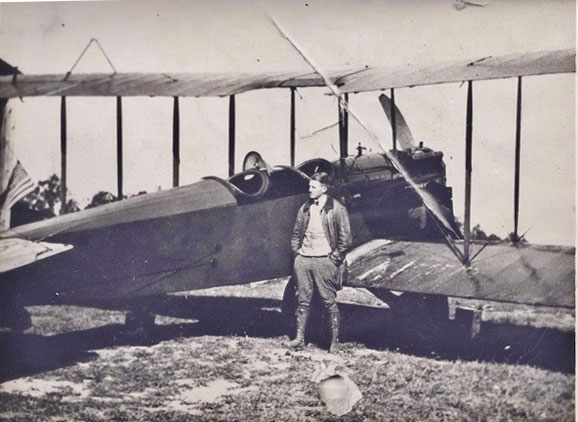 |
Bartow's second landing was six weeks later on June 19, 1930. This time he flew the Stinson Model SM-8-A he identified as NC941W. As with his first landing, he cited his home base as Central Airport, Camden, NJ. He cited no passengers, destination, or purpose for his flight
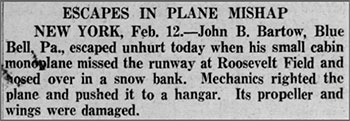 |
Bartow moved from Central Airport to co-found Wings Airport, Blue Bell, PA on May 23, 1930, which was about the same time as his landings at Willow Grove (Clarion County is at the west end of the state; Wings Airport is in Montgomery County at the east end, near Central). Wings Airport still operates as Montgomery County Municipal Airport, and is featured at the link. Sometime after he moved to Blue Bell, right, he nosed an airplane over at Roosevelt Field, LI, NY and damaged the wings and propeller. There was information in the article that identified the airplane.
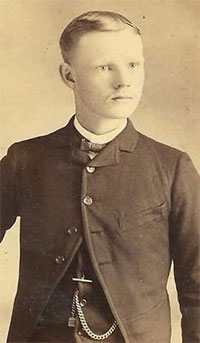 |
John Bartow was born June 24, 1897. His parents were Orville Adalphus Bartow, left, (a carpenter; 1865-1935) and Mary Roxie Whitley (1869-1917). As a young man, Bartow enlisted in the army June 22, 1916 and was discharged May 24, 1919. He reenlisted on May 29, 1919 and was again discharged June 18, 1920, only to reenlist on June 19th. He was then finally discharged on August 17, 1921. He held the grade of Flying Cadet with the Air Service in the 11th Bombardment Group. I found no other details regarding his military service.
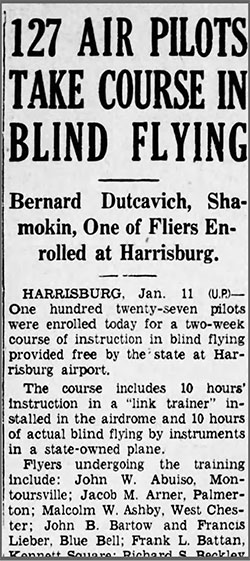 |
The 1930 Census placed him at age 32 living with his wife, Hazel (25) and young son, Jack A. (2). Bartow had married Hazel Virginia (ca. 1905-?) four years earlier. They lived at 111 Kendall Boulevard, Camden, NJ. This address today holds a modest fieldstone home with a swimming pool in the backyard. His occupation was listed as "Aviator" in "Aviation." This explains his citation, above, of Central Airport as his home base.
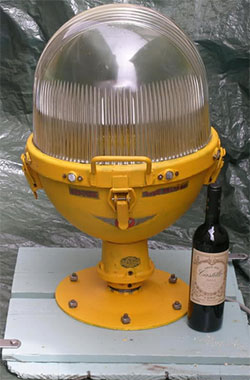 |
Further, besides his flying activities, and probably more important, Bartow perfected modern runway lighting and rotating beacons for night landings. According to the Wings Field Autobiography cited at the Wings Airport link, "Jack Bartow, one of the original owners of Wings Field, 'invented, tested, and perfected runway lighting, left, and the rotating beacon that have become fixtures at nearly all public airports.' Bartow created the Airways Beacon, the first navigation system to help pilots at night. His beacons were used during World War II to help pilots in bad weather conditions. He also invented the flood lighting for hangars and flashing beacons for runways. All of Bartow’s inventions were tested and first used at Wings Field." There isn't a pilot flying today who hasn't benefitted from Bartow's inventions, and his advocacy for airport approach lighting.
Above, right, is an article from the Shamokin News-Dispatch (PA), November 11, 1938, which documents Bartow's instrument flight training. I truncated this article because the rest of it was simply a listing of other pilots who took the training (none were Register pilots). This is an important article, though, because it documents part of a wave of instrument flight training that was rolled out by the military, and then to civil pilots, via the federal government, during the late 1930s to increase flight safety. Register pilot Robert Henderson was responsible for delivering some of the training to pilots in the greater New York City area. For more background, see also Register pilot Albert Hegenberger.
Below, from the York Gazette-Daily (PA) of June 5, 1939 is an article that describes Bartow's contributions to airport lighting science. I left a related article on airline safety attached. It is a nice summary of how airline safety increased markedly during the late 1930s.
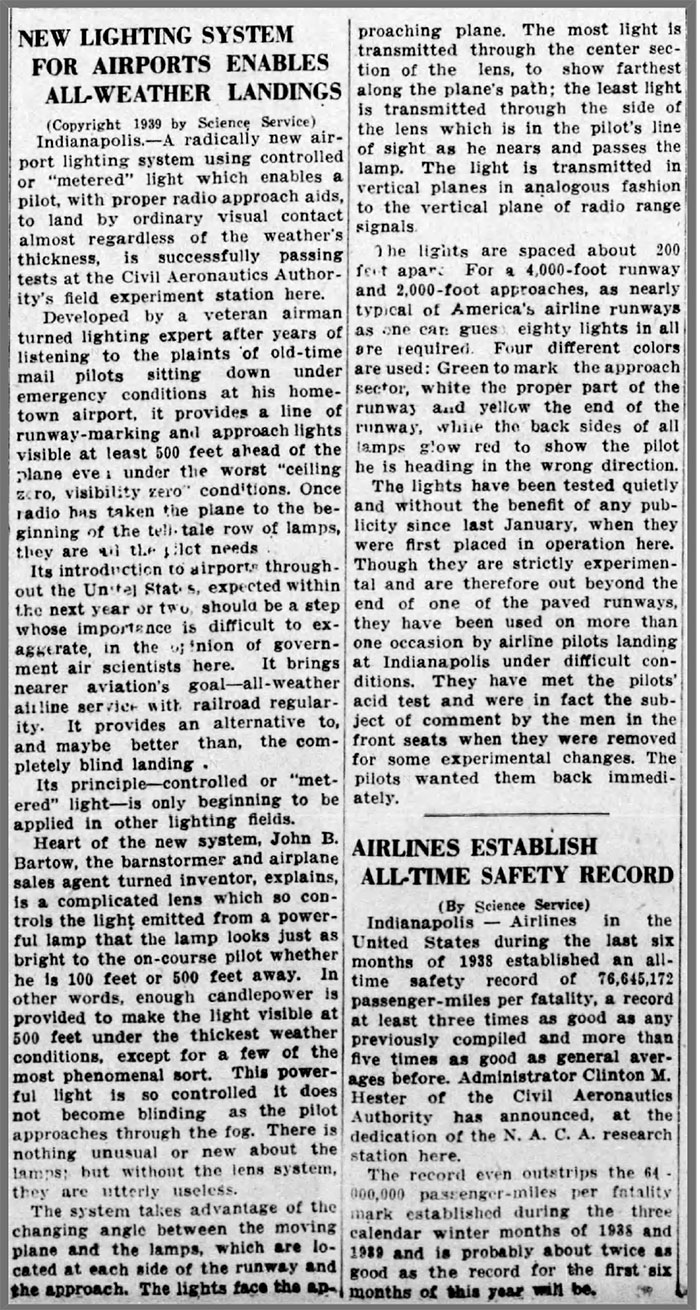 |
 |
Apparently, sometime during the 1930s he reduced his aviation work and focused on his airport lighting efforts and inventions. The 1940 Census cited him living at 180 Walton Road, Whitpain, PA. His occupation was described as "Electrician" for "Lights, Airport." At age 42, he lived with Hazel (34) and Jack (12). They owned their home, which was valued at $3,500. According to the Census, they had lived in this home since at least 1935, which makes sense, since he moved from Camden to be near his Montgomery County airport ca. 1930.
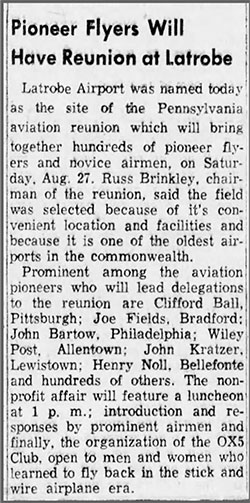 |
A news article from The New York Times, December 15, 1940, right, described a binocular device for pilots that Bartow invented. Worn over the pilot's eyes, it allowed improved three-dimensional interpretation of objects at a distance. I have abridged the discription of his invention from the entire article, which, in addition to Bartow's invention, described various other advancements in science, including more potent vaccines and an improved aspirin.
Other than a few news articles, I have no information about his activities during WWII, or after. Examples from the 1950s-60s follow. If you can help fill in the blanks, please let me KNOW.
The first, left, from the Franklin News-Herald (PA), June 27, 1955, described a reunion of pioneer pilots at Latrobe Airport near Pittsburgh, PA. Note that Clifford Ball showed up as a passenger on a flight through Pitcairn Field ca. May 12, 1928. Among the others listed, only John Kratzer was a Register pilot (the Wiley Post of the Registers was killed in the mid-1930s).
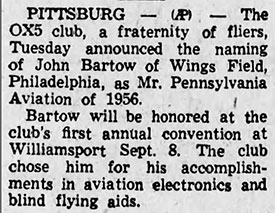 |
Another, left, from the Altoona Tribune, August 29, 1956 described Bartow being named "Mr. Pennsylvania Aviation of 1956" by the OX-5 Club. His developments of twenty years earlier were recognized.
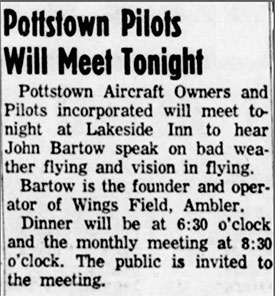 |
Finally, right, the Pottstown Mercury (PA) of November 17,1960, described a pilot town meeting where Bartow was the featured speaker. His topic, as usual, was pilot vision and instrument flying.
Bartow flew West less than a year after the Pottstown meeting, on August 29, 1961 at age 64. We can be sure, regardless of weather, he found his way. His death certificate, below, gave the cause of death as "coronary occlusion" at his office. His occupation was listed as "Executive." I smudged his Social Security Number.
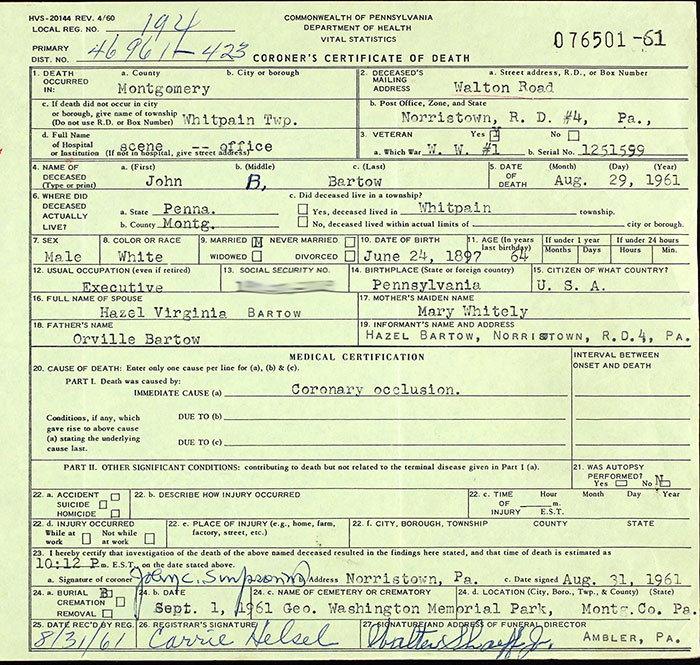 |
Barton was buried at Whitemarsh, PA. His widow, Hazel, applied for and received a military veteran's grave marker (flat bronze). Her two-sided application, from September 8, 1961, is below.
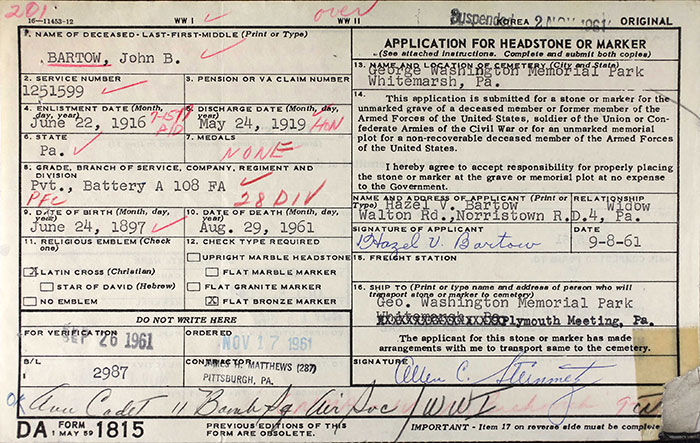 |
Reverse is below.
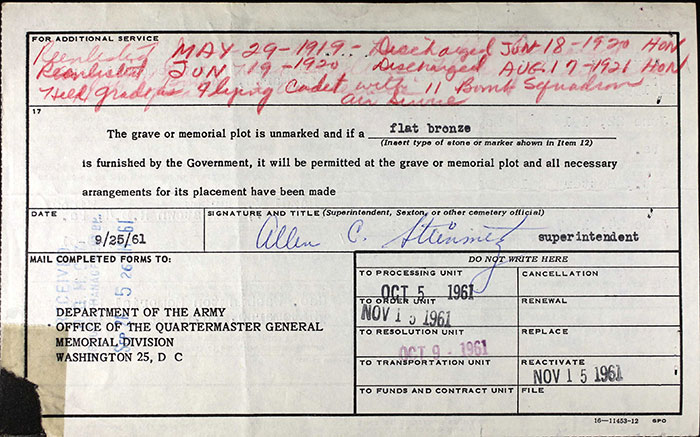 |
---o0o---
SPONSORED LINKS
THIS PAGE UPLOADED: 11/28/16 REVISED:
